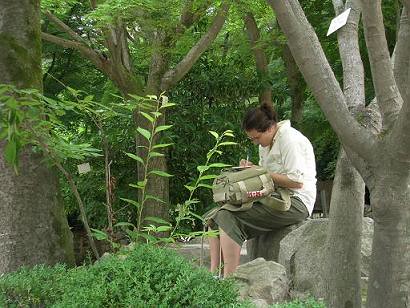Nestle makes a powdered milk, called Nido. It is, in theory, suppose to ensure that children have milk accessible to them even when they don’t have refrigeration. However, it may quite possibly be one of the most expensive items I have seen in any grocery store. A small tin (400g) is sh 10,000, the large continers (which are covered in dust because no one can ever buy them) are more than sh 55,000 (depending on where you go). Most of the time HIV positive mothers, who are trying to raise their babies on something besides breast milk can’t afford it – so their babies die of malnutrition instead of AIDS. Many mothers in rural 
My tour through Kuluva hospital, 9kms outside Arua, included a stop at their feeding centre/nutritional ward. It was the first time for me to see one. It was really well organized and the nurse in charge, Irene, is bright and bubbly. But, she has a tough time and needs to work very hard. Maize meal gets donated “by the people of
Mothers are taught how to properly feed their child, and while at the nutrition ward children should be eating every three hours. The ones that have been there for a while are starting to loose the sunken eyes and smile when they see you. Those that are new have their shoulder blades stick out of their backs, their stomachs are so distended, and they don’t smile, or cry. They just sit wherever they have been put down and wait. It is just like every horrible world vision video designed to part donors from their money, but in reality its worse.
You can spot a child who is malnourished a mile away, even when they are not wasting away. The first sign is the normally jet-black curly hair begins to turn brown; sometimes the hair falls out in patches, and others it goes straight. The skin begins to change also, eyes start to yellow. Then the joints start to stick out. Their bones are much more pronounced. Bellies are big and round, but ribs stick out around the belly. I’m not a medical professional so don’t take this as a guide, but it is usually pretty obvious.
These women are not bad mothers. They simply do not have access to the foods that provide a balanced diet. You can teach a woman anything you want, and believe me she wants what’s best for her children, but if she is too poor, there is nothing she can do about it. Irene told me stories of mothers cooking and mashing sweet potatoes. The cooled potato they make a slurry/solution with water and this is how they feed their infants. If sweet potato is the only thing available – what else can these mothers do?
Children are resilient though. Mothers, and for the most part it is mothers and mothers only, can carry in a child that is totally unresponsive, and limp. And I was told that with proper treatment the child will at least be smiling within a few days. It gives me hope anyway, because some of the kids I saw there didn’t even flinch when nurses were putting in very large IV needles.



No comments:
Post a Comment